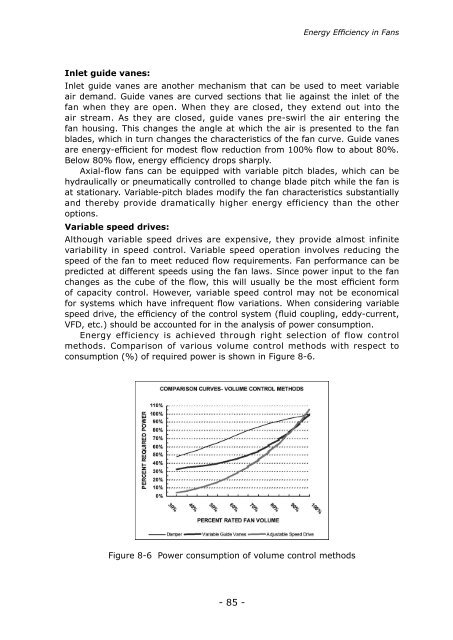Training Manual on Energy Efficiency - APO Asian Productivity ...
Training Manual on Energy Efficiency - APO Asian Productivity ...
Training Manual on Energy Efficiency - APO Asian Productivity ...
You also want an ePaper? Increase the reach of your titles
YUMPU automatically turns print PDFs into web optimized ePapers that Google loves.
Inlet guide vanes:<br />
Inlet guide vanes are another mechanism that can be used to meet variable<br />
air demand. Guide vanes are curved secti<strong>on</strong>s that lie against the inlet of the<br />
fan when they are open. When they are closed, they extend out into the<br />
air stream. As they are closed, guide vanes pre-swirl the air entering the<br />
fan housing. This changes the angle at which the air is presented to the fan<br />
blades, which in turn changes the characteristics of the fan curve. Guide vanes<br />
are energy-efficient for modest flow reducti<strong>on</strong> from 100% flow to about 80%.<br />
Below 80% flow, energy efficiency drops sharply.<br />
Axial-flow fans can be equipped with variable pitch blades, which can be<br />
hydraulically or pneumatically c<strong>on</strong>trolled to change blade pitch while the fan is<br />
at stati<strong>on</strong>ary. Variable-pitch blades modify the fan characteristics substantially<br />
and thereby provide dramatically higher energy efficiency than the other<br />
opti<strong>on</strong>s.<br />
Variable speed drives:<br />
Although variable speed drives are expensive, they provide almost infinite<br />
variability in speed c<strong>on</strong>trol. Variable speed operati<strong>on</strong> involves reducing the<br />
speed of the fan to meet reduced flow requirements. Fan performance can be<br />
predicted at different speeds using the fan laws. Since power input to the fan<br />
changes as the cube of the flow, this will usually be the most efficient form<br />
of capacity c<strong>on</strong>trol. However, variable speed c<strong>on</strong>trol may not be ec<strong>on</strong>omical<br />
for systems which have infrequent flow variati<strong>on</strong>s. When c<strong>on</strong>sidering variable<br />
speed drive, the efficiency of the c<strong>on</strong>trol system (fluid coupling, eddy-current,<br />
VFD, etc.) should be accounted for in the analysis of power c<strong>on</strong>sumpti<strong>on</strong>.<br />
<strong>Energy</strong> efficiency is achieved through right selecti<strong>on</strong> of flow c<strong>on</strong>trol<br />
methods. Comparis<strong>on</strong> of various volume c<strong>on</strong>trol methods with respect to<br />
c<strong>on</strong>sumpti<strong>on</strong> (%) of required power is shown in Figure 8-6.<br />
Figure 8-6 Power c<strong>on</strong>sumpti<strong>on</strong> of volume c<strong>on</strong>trol methods<br />
- 85 -<br />
<strong>Energy</strong> <strong>Efficiency</strong> in Fans
















